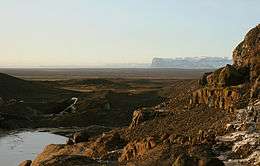Latest News for: outwash plain
Edit
15,000 years ago, a glacier covered Rhode Island. Explore its rocky relics in Charlestown.
The Providence Journal 26 Apr 2024
Edit
 Cleburne Times-Review
06 Jan 2024
Cleburne Times-Review
06 Jan 2024
On Nature column: Glaciers determined the natural areas of Central Indiana
 Cleburne Times-Review
06 Jan 2024
Cleburne Times-Review
06 Jan 2024
The natural regions of Central Indiana are mostly characterized by relatively flat till plains composed of material left by the Wisconsin glacial period ... The Bluffton Till Plain was formed by the later Erie-Ontario glacial lobe.
Edit
Sand and dust storm frequency increasing in many world regions, UN warns
Phys Dot Org 15 Nov 2023
The UNCCD is one of three Conventions originated at the 1992 Earth Summit in Rio de Janeiro ... Background ... Globally, the main large dust sources are dried lakes; Local sources include glacial outwash plains, volcanic ash zones and recently plowed fields.
Edit
Ecological restoration practices showcased at Montague Plains tour
The Recorder 31 Oct 2023
According to the Society for Ecological Restoration and MassWildlife, the Montague Plains area is an 1,800-acre sandplain remnant of an outwash delta from glacial Lake Hitchcock, which occupied much ...
Edit
A tasty snack is waiting for you on Maine hiking trails this summer
Bangor Daily News 28 Aug 2023
Editor’s note. This story was originally published in July 2022 ... This year, it happened on the Fourth of July ... But I had hope ... That’s the weight of ... It naturally inhabits mountain tops and glacial outwash plains that formed about 10,000 years ago.
Edit
Rare frosted elfin caterpillar spotted in Montague wildlife area
The Recorder 18 Jul 2023
He explained that the habitat is an “outwash plain” and a remnant of Glacial Lake Hitchcock, the massive body of water that occupied what is now the Connecticut River Valley thousands of years ago.
Edit
 Elko Daily Free Press
19 Jun 2023
Elko Daily Free Press
19 Jun 2023
JeanMarie Brownson: Get festive for the Fourth of July with red, white and blueberries
 Elko Daily Free Press
19 Jun 2023
Elko Daily Free Press
19 Jun 2023
The Cooperative Extension of The University of Maine informs us “this crop is not planted, but inhabits large fields on mountaintops and in glacial outwash plains, which formed 10,000 years ago ... All summer long ... 1 cup plain Greek yogurt or sour cream ... .
Edit
Can intentional forest burning across the Great Lakes help prevent runaway wildfires?
Michigan Live 18 Jun 2023
Jack pine fires. Most of Michigan’s pine barrens are in Northern Lower Michigan and the Upper Peninsula, but the heart of the state’s jack pine ecosystem specifically can be found among the sandy outwash plains between Grayling and Mio ... Related ... ....
Edit
 The Providence Journal
30 Sep 2022
The Providence Journal
30 Sep 2022
Hike through unique Ice Age terrain at Dr. John Champlin Glacier Park: Walking RI
 The Providence Journal
30 Sep 2022
The Providence Journal
30 Sep 2022
Edit
 Portsmouth Herald
23 Aug 2022
Portsmouth Herald
23 Aug 2022
Nature News: Rare northern blazing stars found in abundance on Maine's Kennebunk Plains
 Portsmouth Herald
23 Aug 2022
Portsmouth Herald
23 Aug 2022
Edit
 The Daily Telegram
18 Aug 2022
The Daily Telegram
18 Aug 2022
Precision farming with strip till systems
 The Daily Telegram
18 Aug 2022
The Daily Telegram
18 Aug 2022
There is significant discussion over soil management and water quality ... Lenawee County is situated on lake plains and in depressional areas on moraines, outwash plains and glacial drainage ways ... Deborah J. Comstock is a local small farmer ... .
Edit
Letters to the Editor for August 11, 2022
The East Hampton Star 11 Aug 2022
Before Europeans arrived, Long Island’s glacial outwash plains were covered with pine barrens and native grassland suited for our poor, well-drained sandy soils, grasslands interspersed with colorful ...
Edit
There’s a tasty snack waiting for you on Maine hiking trails this summer
Bangor Daily News 08 Jul 2022
Wild blueberry season sneaks up on me every year, and I don’t mind the scrumptious surprise one bit. This year, it happened on the Fourth of July ... It naturally inhabits mountain tops and glacial outwash plains that formed about 10,000 years ago ... ....
Edit
 The Providence Journal
27 May 2022
The Providence Journal
27 May 2022
Walking RI: Ninigret National Wildlife Refuge harbors naval, tribal history
 The Providence Journal
27 May 2022
The Providence Journal
27 May 2022
Now, flat-bottomed boats cruise the pond to harvest traps filled with oysters and mussels ... After a break, we retraced our steps to a trail junction and took a left on the Cross Edge Trail through what’s called a glacial outwash plain ... Access.
- 1
- 2
- Next page »


